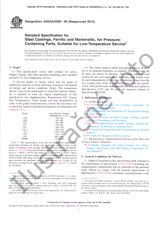Potrebujeme váš súhlas na využitie jednotlivých dát, aby sa vám okrem iného mohli ukazovať informácie týkajúce sa vašich záujmov. Súhlas udelíte kliknutím na tlačidlo „OK“.
ASTM D7527-10(2018)
Standard Test Method for Measurement of Antioxidant Content in Lubricating Greases by Linear Sweep Voltammetry
NORMA vydaná dňa 1.4.2018
Informácie o norme:
Označenie normy: ASTM D7527-10(2018)
Poznámka: NEPLATNÁ
Dátum vydania normy: 1.4.2018
Kód tovaru: NS-848415
Počet strán: 7
Približná hmotnosť: 21 g (0.05 libier)
Krajina: Americká technická norma
Kategória: Technické normy ASTM
Kategórie - podobné normy:
Anotácia textu normy ASTM D7527-10(2018) :
Keywords:
2,6-di-tert-butyl-4methylphenol, 2,6-di-tert-butylphenol, alkylated diphenylamine, aromatic amine antioxidant, grease, hindered phenol antioxidant, linear sweep voltammetry, phenyl alpha naphthylamine,, ICS Number Code 75.100 (Lubricants, industrial oils and related products)
Doplňujúce informácie
| Significance and Use | ||||||||||
|
4.1 The quantitative determination of antioxidants in new greases measures the amount of the chemical compounds that were added to the base oil as protection against grease oxidation. For in-service oil greases, the voltammetric test method measures the amount of original (individual) antioxidants remaining after grease oxidation have reduced its concentration. Before making final judgment on the remaining useful life of the in-service grease, which might result in the replacement of the grease reservoir, it is advised to perform additional analytical techniques, such as Test Method D942 and D5483, which may be used to measure the remaining oxidative life of the used grease. 4.1.1 This test method is applicable to mineral oil-based and synthetic oil-based greases, based on all type of applied thickeners. This test method is applicable to greases containing at least one type of antioxidant. The presence of other types of additives like corrosion inhibitors or metal deactivators will not interfere with this test method. 4.2 When a voltammetric analysis is obtained using a neutral acetone test solution for a grease inhibited with a typical synergistic mixture of hindered phenol and aromatic amine antioxidants, there is an increase in the voltammogram current between 8 s to 12 s (or 0.8 V to 1.2 V applied voltage), see Note 1, for the aromatic amines, and an increase in the voltammogram current of the produced voltammogram between 13 s to 16 s (or 1.3 V to 1.6 V applied voltage), see Note 1, for the hindered phenols. In Fig. 1, x-axis = 1 s = 0.1 V. Hindered phenol antioxidants detected by voltammetric analysis include, but are not limited to, 2,6-di-4.3 For greases containing only aromatic amines as antioxidants, there will only be an increase in the current of the produced voltammogram between 8 s to 12 s (or 0.8 V to 1.2 V applied voltage) for the aromatic amines, by using the neutral acetone test solution (first peak in Fig. 1). 4.4 For greases containing ZDDP as antioxidants, there shall be an increase in the voltammogram current between 6 s to 10 s (or 0.6 V to 1.0 V applied voltage), see Note 1, for the ZDDP, when evaluated in the neutral acetone test solution. 4.5 For greases containing only hindered phenolic antioxidants, basic alcohol test solutions are recommended for use as described in Test Method D6810. In basic alcohol test solutions, the voltammogram current for phenols increases between 3 s to 6 s (or 0.3 V to 0.6 V applied voltage), see Note 1. In Fig. 2, x-axis = 1 s = 0.1 V are as described in Test Method D6810, where x-axis = time (seconds) and y-axis is current (arbitrary units). Top line in Fig. 2 is fresh grease. |
||||||||||
| 1. Scope | ||||||||||
|
1.1 This test method covers the voltammetric determination of antioxidants in new or in-service lubricating greases in concentrations from 0.0075 weight percent up to concentrations found in new greases by measuring the amount of current flow at a specified voltage in the produced voltammogram. 1.2 This test method is intended to monitor the antioxidant content in lubricating greases; it cannot be applied for lubricating greases that do not contain antioxidants. 1.3 This test method is designed to allow the user to monitor the antioxidant depletion rate of in-service greases through its life cycle as part of condition monitoring programs. This test method is performed in order to collect and trend early signs of deteriorating lubricant grease, and it may be used as a guide for the direction of any required maintenance activities. This will ensure a safe, reliable, and cost-effective operation of the monitored plant equipment. 1.4 The values stated in SI units are to be regarded as standard. No other units of measurement are included in this standard. 1.5 This standard does not purport to address all of the safety concerns, if any, associated with its use. It is the responsibility of the user of this standard to establish appropriate safety, health, and environmental practices and determine the applicability of regulatory limitations prior to use. 1.6 This international standard was developed in accordance with internationally recognized principles on standardization established in the Decision on Principles for the Development of International Standards, Guides and Recommendations issued by the World Trade Organization Technical Barriers to Trade (TBT) Committee. |
||||||||||
| 2. Referenced Documents | ||||||||||
|
Odporúčame:
Aktualizácia technických noriem
Chcete mať istotu, že používate len platné technické normy?
Ponúkame Vám riešenie, ktoré Vám zaistí mesačný prehľad o aktuálnosti noriem, ktoré používate.
Chcete vedieť viac informácií ? Pozrite sa na túto stránku.




 Cookies
Cookies
